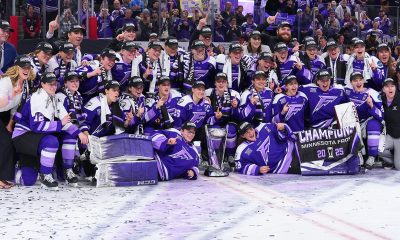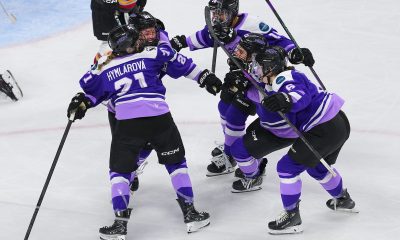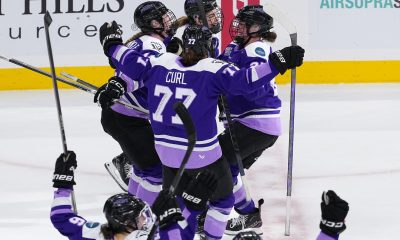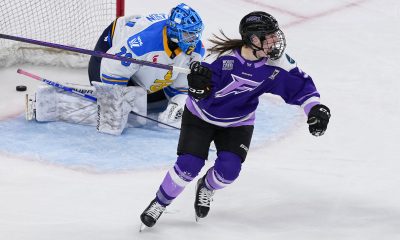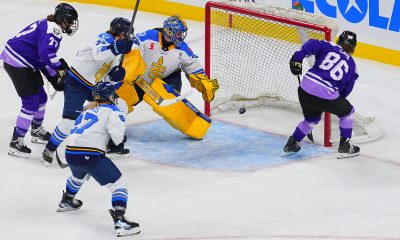
Thoughts of two leading men in the game of hockey on what steps need to be taken to protect hockey players from head injuries.
Hockey Concussions Part Two:
This is part two of my hockey concussion research. In this part I spoke with Tom Babson from the Sports Legacy Institute, which is performing cutting edge technology, programs when it comes to the study of concussions. I also had the privilege of speaking with Ken Dryden who played for the Montreal Canadiens and now is a member of parliament in Canada. As you will see both men have a very unique way in looking at the situation when it comes to concussions in hockey and what needs to take place to make the game safer at all levels of play.
Sports Legacy Institute, Tom Babson:
Tom has a very unique background in the sports and entertainment world. He played hockey at St. Lawrence College in the 1960’s, and over the course of playing the sport of ice hockey; he suffered nine concussions, of varied levels of severity. The one issue Tom raised during our conversation was that he kept playing even though he had suffered a head trauma at the time. Tom also coached the woman’s ice hockey team at Boston College. Some of you who watched the television show “Cheers” might remember Tom as Sam Malone’s attorney on the show. It this interesting that someone who suffered the number of concussions that Tom did was able to become an actor and memorize scripts for major television show productions. Tom and the personnel at that the Sports Legacy Institute in Boston has come up with a “Ten Point Plan” to limit hockey concussions. As Tom informed the author, this is a living, breathing plan that can change with the times. It is not written in “Frozen Ice”. Tom coaches his son’s Bantam hockey team and wants to change the culture and understanding in hockey so others don’t suffer what he did when it came to his concussions. Tom believes that the health issues he experiences today, as he gets older are tied to his playing days. The following are Tom’s and the Sports Legacy Institute’s thoughts for the plan.
10 Point Plan to Limit Hockey Concussions
1. Encourage mandatory brain trauma and concussion education for coaches, athletic trainers, parents and athletes. Coaches, athletic trainers and athletes cannot diagnose
concussions if they aren’t trained to look for them or know how to recognize them. Coaches, athletic trainers, and athletes will not voluntarily choose to rest concussions and reduce overall brain trauma if they don’t understand why it is good for the athlete’s short and long-term health.
2. Reevaluate how the game is taught. The number one cause of concussion in hockey comes from contact to the head. Most of these contacts come from a player trying to check another player or a player trying to defend a check from another player. It is therefore imperative for those adults in positions of teacher, coach or instructor to teach players from the earliest levels how to physically control themselves at all times so as to keep sticks, hands, elbows and shoulders from making any contact to another players head, for any reason. Techniques and methodologies should be developed to teach the proper, safe way to hit, check, take a check, or make contact with another player. This basic premise should be mandated at all local youth association training practices (from learn to play, up), camps and clinics. Then from peewees to bantams to high school to college to the pros, from the coaches and the refs, the mantra should be never make contact with another player’s head. Incidental and accidental contact is always going to be a part of the game of hockey, but intentional contact should always be in control and rigorously supervised. If a player cannot control his or her actions so that they potentially create sever bodily harm or death, then that player should be removed from the game.
3. Reevaluate protective equipment. Investigate changes to helmets, mouth guards and other hard-shell pads to reduce brain trauma.
4. Develop better methods of concussion detection and diagnosis. Coaches and trainers as first responders. Should referees be in a role of a first responder as they are in many youth leagues? Pre-screening and base lining of each player should be advised. The CDC provides clipboards with concussion diagnosis protocols on the back at no cost. Coaches could be required to have him or her available on the bench for each practice and game. We can invest more in research to find simple, objective ways to diagnose concussion that can be utilized in any program.
5. Develop better methods of concussion management. Return-to-play too soon after concussion can result in more extensive brain damage and can actually result in death. Many times it is the second hit to the head in the same game (even a minor one) that can do the most damage. In football, many states are requiring athletes to see a medical professional with brain expertise before return-to-play. Minimum return-to-play standards should be enforced at all levels.
6. Continue the scientific and systematic study of concussion and CTE. The cause, effects, treatment and future effects should continue to be studied and supported.
7. Reevaluate coaching philosophy to minimize contact to the head. Is the purpose of checking to separate the player from the puck? What role should intimidation play in the game and at what age levels? Finishing the check is a major source of contacts to the head. When should a player hit and for what reason? What legal/moral responsibility should the coaches have in their players’ behavior on the ice?
8. Revaluate the rules. Are existing rules adequate or do we need more specific rules as they relate to all forms of hitting where concussion is a result? Should contact to the head should be emphasized as strongly as checking from behind. Further exploration into the differences in NHL, USA Hockey, International Associations, NCAA and State-by-State rules and their interpretations as well as age level and gender differences should be undertaken.
9. Reevaluate rule enforcement and the role of referees. How do referees individually interpret the rules during a game? Some potential issues include the lack of consistency and wide divergence of judgment calls, referees’ ethical responsibility to the safety of players; the results of Just let them play mind-set; and some leagues have a rule that when a player is hurt, only the referee can attend the player until they decide to allow the coach to come onto the ice. Is this a safe protocol? How should first response best be handled?
10. Reconsider the culture of the game. Research into the Culture of Contact as it applies to league administrators, coaches, parents, players and refs needs to be conducted. How is hitting looked at in the attitudes of Mites through the NHL? What are the reasons checking or hitting is in the game and should there be a place for Intimidation as a tactic? There are also issues with age and gender differences and attitudes. (Tom Babson, Sports Legacy Institute, Boston, MA).
Ken Dryden, Member of Canadian Parliament for York Center:
I had the pleasure to speak with Ken Dryden on March 23, 2010 about the concussion issue in the game of ice hockey. As many of you know Mr. Dryden has had amazing career since graduating from Cornell University. He played goalie for the Montreal Canadians. Graduated from McGill University Law School. Was the General Manager of the Toronto Maple Leafs and now is a member of the Canadian Parliament. Mr. Dryden, presented amazing insights to what needs to be done to correct the problem for the players to be working in a safe environment in regards to head shots. We started off by discussing the role of the government interceding on behalf of the business of the NHL, here are his thoughts.
It is not the job of the government neither of the United States nor for that matter of Canada to intercede in any rules or regulations when it comes to sports. They can suggest and have standards that must be met but government should never be part of the rules and regulations of how the sports should be governed and operated for the field of play.
People do not want government interference when it comes to sports. It usually backfires on the people who are trying to regulate the games. It is more the job of government to make suggestions to help with the regulation of sport. It is unprecedented for any government in Canada or USA to regulate professional sports in the modern era of sports today.
When the game of hockey was first created it was an offshoot of rugby. Over time and years the game has been refined. The original game looked like soccer. There were no substitutes that entered the game during play. So with that being documented players on the ice needed to learn how conserve their energy to play a full 60 minutes on the ice. There was also no forward passing so players had to learn how to control the puck on their sticks and move it forward up the ice. The game was played more for recreation and enjoyment than taken as serious today.
When the game introduce subs or extra players, time on the ice dropped dramatically, to shifts which lasted anywhere from four to five minutes.
Mr. Dryden informed me during our discussion that he studied and watched games from the 1950’s on kinescope and he told me that when rosters expanded at that time in the 1950’s, player shifts and speed of the game increased a little. In the 1950’s shifts were lasting from 2:00 to 3:00 minutes on the ice and players still had to conserve energy but would have sudden bursts on offense and defense when play warranted during the game action.
In the 1970’s the shifts got shorter down to 1:00 minute in length and the speed increased again in the game and physical play increase dramatically. Now today in 2010 you have players who skate for on average 30 to 40 seconds and when they enter the game over the boards they are moving at sprinting speed so the chances of injury increase. Just think physics, more speed +mass (body size) = great impacts of physical play.
When it comes to equipment the sport began without much protection and no helmets, so if something hurt when you did something during the action, you surmised that the action was not wise to do and it would result in injury if done again. As time progressed more equipment was added and players began to take more risks in the game.
Just as in baseball, mitts used to be gloves and now they are very large to make the baseball disappear when caught. In the game of football larger pads on shoulders and legs. If you look at and study the game of football in the beginning not much protection was used by players on the field.
The two most vulnerable parts of the body in sports, head and knees, they are the most injured out of any of the parts of the body.
In ice hockey rules changed over time and two rules, which were introduced in the game, were high-sticking and elbowing. If you notice when the referees call these infractions, they usually involve the head and neck area of the player.
Mr. Dryden said, “You can’t hide behind the nature of the game changes as it has evolved over time. “The spirit of the game” as it were changes over time and progresses.”
Headshots are extremely dangerous to any player in any sport. They can have adverse effects on a person’s life as they age into their 50’s, 60’s. Window of time for a professional athlete is so small on average; there is more life to live when career is over.
The greatest impact on headshots comes down to the interpretation of the interference rule in hockey.
When a player who is carrying the puck releases the puck be it for a pass or to clear it, and he is checked that player could not be ready for the hit, he has the greatest chance of being injured after release of the puck. In hockey the hit is referred to as finishing your check, but it is a very dangerous play. Mr. Dryden has never understood why anyone would want to check someone who has just released the puck and is not ready to absorb the check. They are no reasons for the hit.
If a defensive player is trying to impede the progress of the puck carrier and can’t get there to check them, that player needs to pull up as it were on their path to deliver the check. There is no reason to hit another player after they release the puck. Don’t take yourself out of the play, just to make a hit. Wastes time and energy.
The puck carrier is the winner and puck pursuer is the loser. It happens. It is a bizarre play to him. Why do you want to check someone without the puck? The checker has to have some responsibility when it comes to their actions during the game. You want to separate the player from the puck. That is objective of a body check. It is not the objective to drill him. Yes, you can send a message when you check him but to hit someone for the sake of hitting them is wrong when they don’t have the puck on their stick.
His feeling is this play should be intent to injure and carry stiff penalties, on and off the ice.
If you called this infraction very tough you would stop a lot of the head shots as well the neck area. Headshots to Mr. Dryden are off limits in his opinion.








